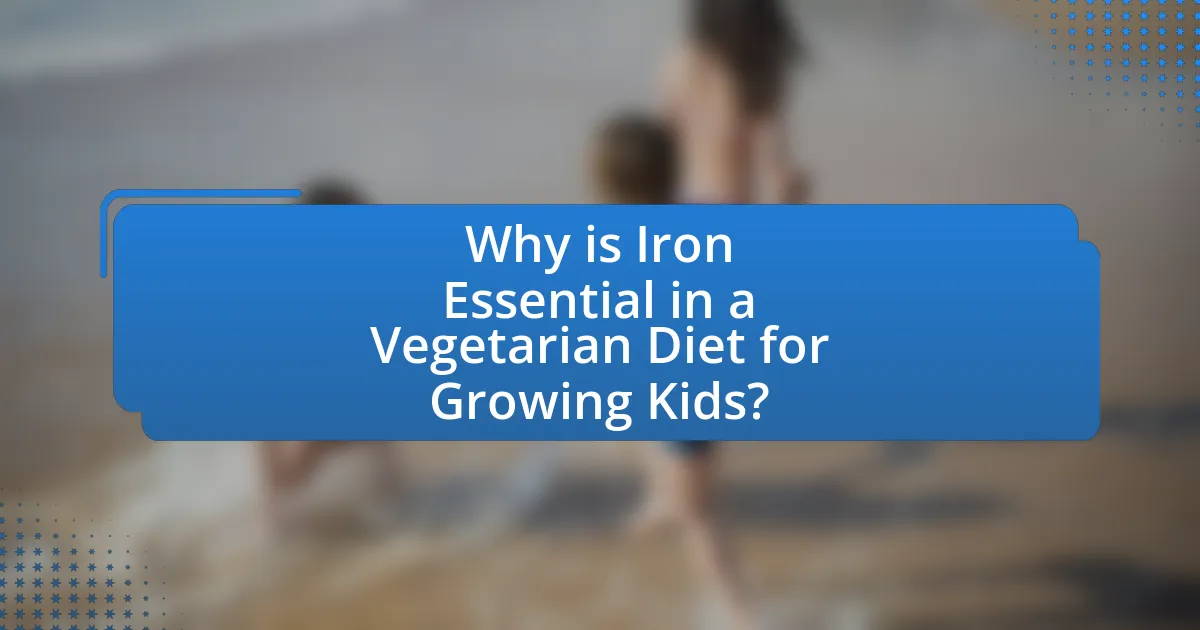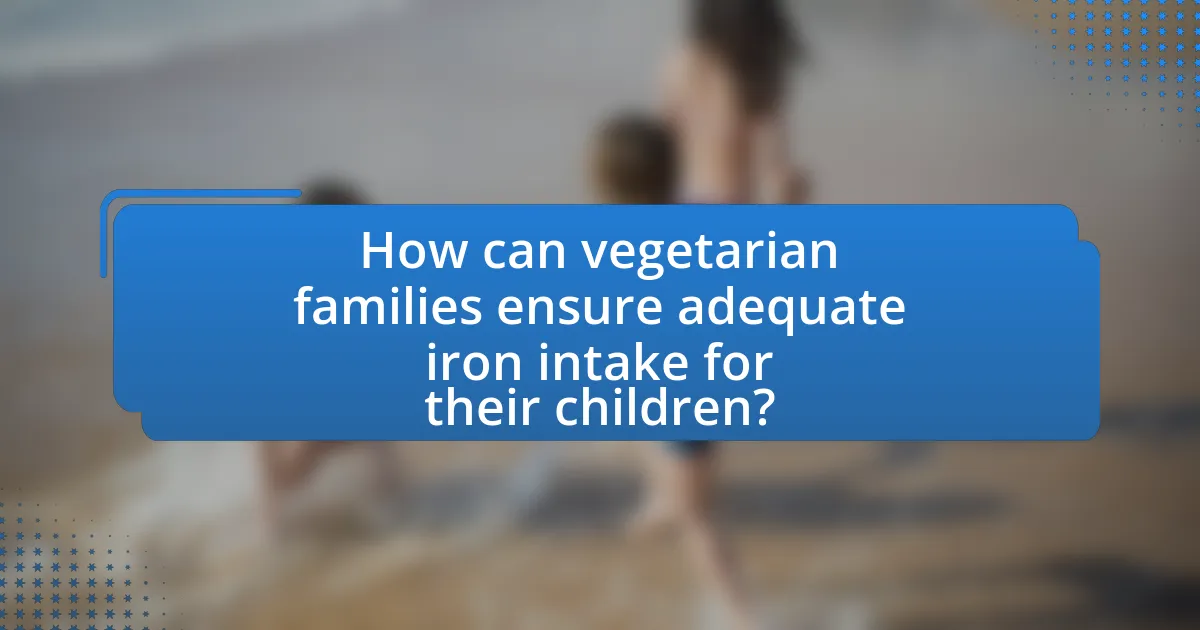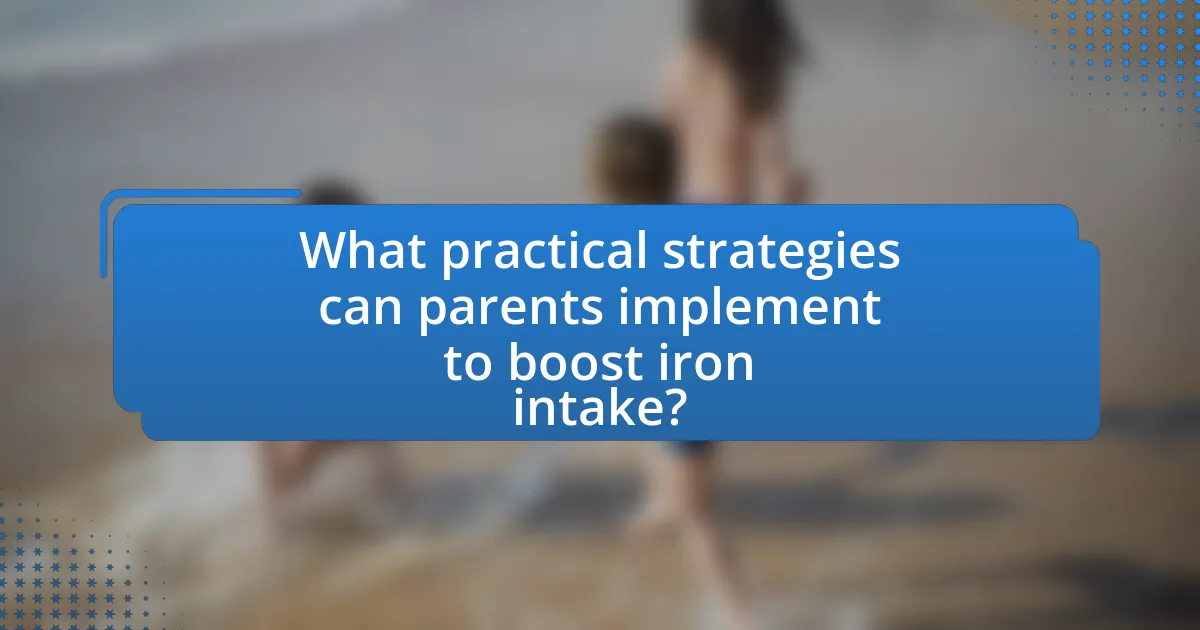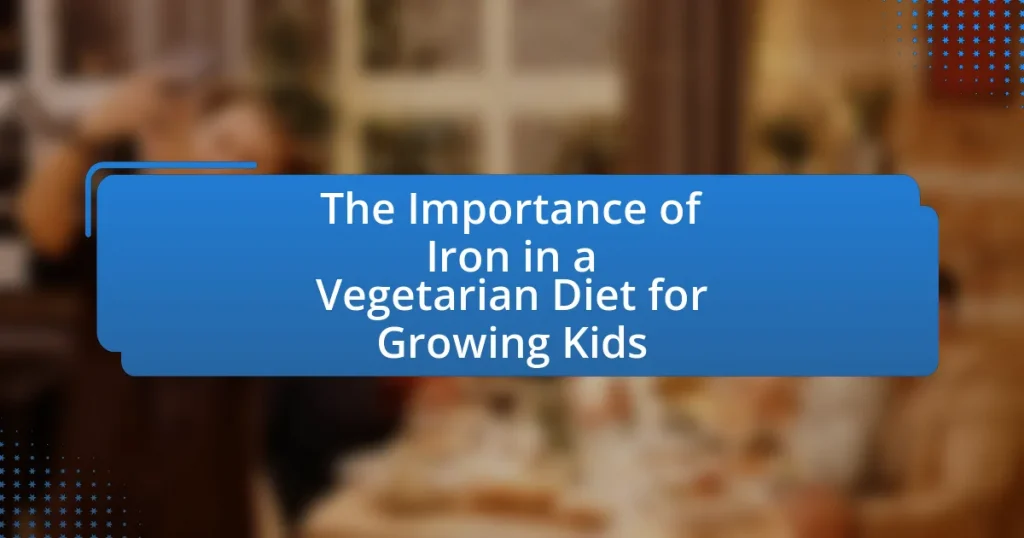Iron is a crucial nutrient in a vegetarian diet for growing children, as it supports oxygen transport, energy production, and cognitive development. Adequate iron intake is essential to prevent iron deficiency anemia, which can lead to fatigue, impaired immune function, and developmental delays. The article outlines the importance of iron for children’s growth, cognitive function, and overall health, emphasizing the risks of deficiency in vegetarian children and providing practical strategies for ensuring sufficient iron intake through diet. It highlights the best plant-based sources of iron, the role of vitamin C in enhancing absorption, and offers meal planning tips and recipes to help parents effectively incorporate iron-rich foods into their children’s diets.

Why is Iron Essential in a Vegetarian Diet for Growing Kids?
Iron is essential in a vegetarian diet for growing kids because it supports critical functions such as oxygen transport, energy production, and cognitive development. Growing children require adequate iron to prevent iron deficiency anemia, which can lead to fatigue, impaired immune function, and developmental delays. Vegetarian sources of iron, such as lentils, beans, and fortified cereals, provide non-heme iron, which is less readily absorbed than heme iron found in animal products. To enhance absorption, it is beneficial to consume vitamin C-rich foods alongside iron sources. Studies indicate that children aged 1-3 years need 7 mg of iron daily, while those aged 4-8 years require 10 mg, highlighting the importance of meeting these nutritional needs through a well-planned vegetarian diet.
What role does iron play in children’s growth and development?
Iron is essential for children’s growth and development as it plays a critical role in the formation of hemoglobin, which is necessary for transporting oxygen in the blood. Adequate iron levels support cognitive development, immune function, and overall physical growth. Research indicates that iron deficiency in children can lead to anemia, which negatively impacts their energy levels, learning abilities, and immune response. According to the World Health Organization, iron deficiency is one of the most common nutritional deficiencies globally, affecting approximately 30% of the world’s population, particularly in children. This highlights the importance of ensuring sufficient iron intake in children’s diets, especially for those following vegetarian diets, where iron sources may be limited.
How does iron contribute to cognitive function in children?
Iron is essential for cognitive function in children as it plays a critical role in the development of the brain and the synthesis of neurotransmitters. Adequate iron levels are necessary for the production of myelin, which insulates nerve fibers and facilitates efficient communication between neurons. Research indicates that iron deficiency in early childhood can lead to impairments in attention, memory, and overall cognitive performance. A study published in the American Journal of Clinical Nutrition found that children with iron deficiency anemia scored lower on cognitive tests compared to their iron-sufficient peers, highlighting the importance of maintaining adequate iron levels for optimal brain development and function.
What are the physical benefits of adequate iron intake for kids?
Adequate iron intake for kids is essential for their physical development and overall health. Iron plays a critical role in the formation of hemoglobin, which is necessary for transporting oxygen in the blood. This oxygen transport is vital for energy production and cognitive function, enabling children to engage in physical activities and learn effectively. Furthermore, sufficient iron levels help support a healthy immune system, reducing the risk of infections and illnesses. Research indicates that children with adequate iron intake demonstrate better physical performance and improved concentration, which are crucial for their growth and development.
What are the risks of iron deficiency in vegetarian children?
Iron deficiency in vegetarian children can lead to anemia, impaired cognitive development, and weakened immune function. Anemia occurs when there is insufficient iron to produce hemoglobin, which is essential for transporting oxygen in the blood. Studies indicate that children with iron deficiency anemia may experience fatigue, decreased attention span, and learning difficulties, impacting their academic performance. Additionally, iron is crucial for immune health; a deficiency can increase susceptibility to infections. According to research published in the Journal of Pediatric Gastroenterology and Nutrition, vegetarian children are at a higher risk for iron deficiency due to lower intake of heme iron, which is more readily absorbed than non-heme iron found in plant sources.
What symptoms indicate iron deficiency in growing kids?
Symptoms indicating iron deficiency in growing kids include fatigue, pale skin, weakness, irritability, and difficulty concentrating. These symptoms arise because iron is crucial for producing hemoglobin, which carries oxygen in the blood. A study published in the Journal of Pediatrics highlights that children with iron deficiency may also experience developmental delays and behavioral issues, further emphasizing the importance of adequate iron intake for their growth and cognitive function.
How can iron deficiency affect a child’s overall health?
Iron deficiency can significantly impair a child’s overall health by leading to anemia, which reduces the oxygen-carrying capacity of the blood. This condition can result in fatigue, weakness, and developmental delays, affecting cognitive and physical growth. According to the World Health Organization, iron deficiency is the most common nutritional deficiency globally, impacting approximately 30% of children under five years old. Furthermore, studies indicate that children with iron deficiency anemia may experience long-term effects on their cognitive development, including lower IQ scores and poorer academic performance.

How can vegetarian families ensure adequate iron intake for their children?
Vegetarian families can ensure adequate iron intake for their children by incorporating iron-rich plant foods and pairing them with vitamin C sources to enhance absorption. Foods such as lentils, chickpeas, beans, tofu, quinoa, fortified cereals, and dark leafy greens are excellent sources of non-heme iron. For instance, a cup of cooked lentils provides about 6.6 mg of iron, while a cup of cooked spinach offers approximately 6.4 mg. Additionally, consuming these foods alongside vitamin C-rich items like oranges, strawberries, or bell peppers can significantly improve iron absorption, as vitamin C converts iron into a more absorbable form. This strategy is supported by research from the National Institutes of Health, which emphasizes the importance of combining non-heme iron sources with vitamin C to optimize iron uptake in vegetarian diets.
What are the best plant-based sources of iron for kids?
The best plant-based sources of iron for kids include lentils, chickpeas, beans, tofu, quinoa, fortified cereals, pumpkin seeds, and dark leafy greens like spinach and kale. These foods are rich in non-heme iron, which is essential for growth and development in children. For instance, one cup of cooked lentils provides about 6.6 mg of iron, while a cup of cooked spinach offers approximately 6.4 mg. Incorporating vitamin C-rich foods alongside these sources can enhance iron absorption, making them even more effective in meeting dietary needs.
How do legumes, nuts, and seeds contribute to iron intake?
Legumes, nuts, and seeds are significant sources of non-heme iron, which is essential for iron intake, especially in vegetarian diets. Legumes such as lentils and chickpeas contain approximately 3.3 mg and 2.9 mg of iron per cooked cup, respectively, while nuts like almonds provide about 1.1 mg per ounce, and seeds such as pumpkin seeds offer around 2.5 mg per ounce. These foods not only contribute to daily iron requirements but also contain additional nutrients that enhance iron absorption, such as vitamin C found in legumes when paired with vegetables.
What role do leafy greens play in providing iron?
Leafy greens play a significant role in providing iron, particularly non-heme iron, which is the type of iron found in plant-based foods. These greens, such as spinach, kale, and Swiss chard, contain varying amounts of iron; for example, cooked spinach offers about 6.4 mg of iron per 100 grams. While non-heme iron is less readily absorbed by the body compared to heme iron from animal sources, the presence of vitamin C in many leafy greens can enhance its absorption. This is crucial for growing kids on a vegetarian diet, as adequate iron intake supports their development and prevents iron deficiency anemia.
How can cooking methods enhance iron absorption from plant sources?
Cooking methods can enhance iron absorption from plant sources by reducing phytate levels and increasing the bioavailability of non-heme iron. Techniques such as soaking, sprouting, and fermenting legumes and grains can decrease phytate content, which inhibits iron absorption. For example, soaking beans before cooking can reduce phytate levels by up to 50%, thereby improving iron availability. Additionally, cooking vegetables can break down cell walls, making iron more accessible. Studies have shown that cooking spinach, for instance, can increase iron absorption by up to 2.5 times compared to raw consumption.
What foods should be combined to improve iron absorption?
To improve iron absorption, combine vitamin C-rich foods with iron-rich foods. For example, pairing spinach (high in non-heme iron) with oranges or bell peppers (rich in vitamin C) enhances the bioavailability of iron. Studies indicate that vitamin C can increase non-heme iron absorption by up to 300%, making such combinations effective for individuals, particularly in vegetarian diets, where iron sources are predominantly non-heme.
How does vitamin C influence iron absorption in vegetarian diets?
Vitamin C significantly enhances iron absorption in vegetarian diets by converting non-heme iron, which is the type of iron found in plant-based foods, into a more absorbable form. This conversion occurs because vitamin C reduces ferric iron (Fe3+) to ferrous iron (Fe2+), which is more readily absorbed by the intestinal cells. Research indicates that the presence of vitamin C can increase non-heme iron absorption by up to 6 times, making it crucial for individuals, especially growing kids on vegetarian diets, who may be at risk of iron deficiency.

What practical strategies can parents implement to boost iron intake?
Parents can boost iron intake in their children by incorporating iron-rich foods into their diets, such as lentils, beans, tofu, spinach, and fortified cereals. These foods provide non-heme iron, which is essential for growth and development. Additionally, pairing these iron sources with vitamin C-rich foods like oranges, strawberries, or bell peppers enhances iron absorption. Research indicates that consuming vitamin C alongside non-heme iron can increase absorption rates significantly, making it a practical strategy for parents to implement.
How can meal planning help in providing sufficient iron?
Meal planning can help in providing sufficient iron by ensuring the inclusion of iron-rich foods in a child’s diet. By strategically selecting meals that incorporate sources of iron, such as legumes, fortified cereals, nuts, seeds, and dark leafy greens, parents can enhance their children’s iron intake. Research indicates that vegetarian diets can be lower in iron, particularly heme iron, which is more readily absorbed by the body. Therefore, meal planning that emphasizes the combination of non-heme iron sources with vitamin C-rich foods, like citrus fruits or bell peppers, can significantly improve iron absorption. This approach not only addresses the nutritional needs of growing kids but also helps prevent iron deficiency anemia, which affects approximately 20% of children globally.
What are some iron-rich vegetarian recipes for kids?
Iron-rich vegetarian recipes for kids include lentil soup, spinach and chickpea salad, quinoa and black bean bowls, and tofu stir-fry. Lentils are an excellent source of iron, providing about 3.3 mg per cooked cup, making lentil soup a nutritious option. Spinach, which contains approximately 6.4 mg of iron per cooked cup, can be combined with chickpeas to create a flavorful salad. Quinoa, offering around 2.8 mg of iron per cooked cup, pairs well with black beans for a protein-rich meal. Tofu, containing about 3.4 mg of iron per half-cup, can be stir-fried with vegetables for a tasty dish. These recipes not only provide essential iron but also incorporate other nutrients vital for children’s growth and development.
How can parents incorporate iron supplements if necessary?
Parents can incorporate iron supplements by consulting a healthcare provider to determine the appropriate dosage and type of supplement needed for their child. Once the healthcare provider recommends a specific iron supplement, parents should administer it according to the instructions, ensuring it is taken with vitamin C-rich foods or drinks to enhance absorption. Research indicates that iron supplements can effectively address iron deficiency anemia, which is particularly relevant for vegetarian diets that may lack sufficient iron sources.
What are common misconceptions about iron in vegetarian diets?
Common misconceptions about iron in vegetarian diets include the belief that vegetarians cannot obtain sufficient iron and that plant-based iron sources are inadequate. In reality, while heme iron from animal sources is more easily absorbed, non-heme iron from plant sources can still meet dietary needs when consumed with vitamin C-rich foods, which enhance absorption. Research indicates that with proper planning, vegetarians can achieve adequate iron intake; for example, the Academy of Nutrition and Dietetics states that a well-balanced vegetarian diet can provide all necessary nutrients, including iron.
How can parents address concerns about iron deficiency in vegetarian children?
Parents can address concerns about iron deficiency in vegetarian children by ensuring a diet rich in iron-containing plant foods and pairing them with vitamin C sources to enhance absorption. Foods such as lentils, chickpeas, quinoa, fortified cereals, and dark leafy greens provide non-heme iron, which is essential for growth and development. Research indicates that combining these iron-rich foods with vitamin C sources like citrus fruits, bell peppers, and tomatoes can significantly improve iron absorption, making it more effective for vegetarian diets. Additionally, parents should consider consulting with a healthcare provider to monitor iron levels and discuss the potential need for iron supplements if dietary intake is insufficient.
What tips can help ensure kids enjoy iron-rich foods?
To ensure kids enjoy iron-rich foods, incorporate these strategies: present iron-rich foods in appealing ways, such as colorful dishes or fun shapes, and involve children in meal preparation to increase their interest. Research indicates that children are more likely to try new foods when they participate in cooking, as it fosters a sense of ownership and curiosity about the food. Additionally, pairing iron-rich foods with vitamin C sources, like citrus fruits or bell peppers, enhances iron absorption, making the meals not only nutritious but also more enjoyable.


